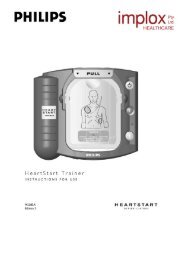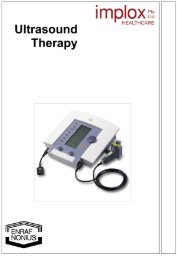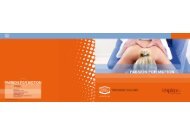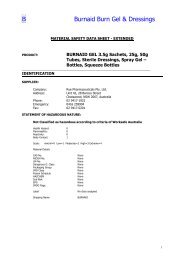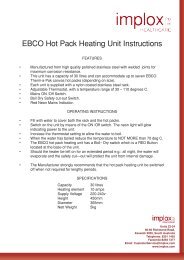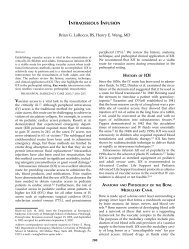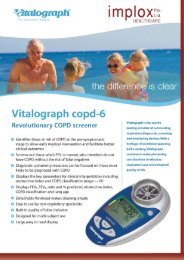Low and medium Frequency Electrotherapy - Implox
Low and medium Frequency Electrotherapy - Implox
Low and medium Frequency Electrotherapy - Implox
Create successful ePaper yourself
Turn your PDF publications into a flip-book with our unique Google optimized e-Paper software.
5.3.2 Russian stimulation<br />
A variation on the latter current type is an intermittent alternating current with a carrier frequency of 2500 Hz. This<br />
current form is referred to as ‘Russian Stimulation’.<br />
Fig. 32.<br />
Russian Stimulation<br />
Kots (13) , a lecturer in sports medicine at the Moscow State Academy, was the first to use <strong>medium</strong>-frequency<br />
alternating currents for muscle strengthening in prosthesiology <strong>and</strong> in the training of Russian cosmonauts. In this<br />
technique the electrostimulation is applied both to individual muscles <strong>and</strong> to groups of muscles (either directly or via<br />
the nerve). In direct stimulation, a frequency of 2500 Hz was found to produce the greatest contraction, while the<br />
optimum frequency in indirect stimulation was 1000 Hz.<br />
A specific feature of this type of muscle stimulation is that the alternating current is interrupted 50 times per second.<br />
This results in a pulse train, comparable to the ‘burst’ in TENS. The total duration of the pulse train is 20 ms, giving a<br />
phase duration/phase interval ratio of 1:1. Kots uses a train frequency (50 Hz) lying more or less in the middle of the<br />
frequency spectrum used to produce tetanic contraction (40-80 Hz). In addition to the 1:1 ratio, Kots also describes a<br />
phase duration/phase interval ratio of 1:5.<br />
The amplitude should be increased until a powerful contraction is produced (from the motor stimulation level up to the<br />
limit of tolerance).<br />
5.3.3 TENS current types<br />
The phase times <strong>and</strong> frequencies used make TENS current types suitable for producing muscle contractions. The<br />
phase duration is usually 100-150 µs. the frequency can be adjusted to according to the type of muscle tissue (phasic<br />
or tonic). A frequency of 50 Hz can be maintained in order to produce comfortable tetanic contractions.<br />
The difference between the TENS currents used for muscle stimulation <strong>and</strong> those used for pain suppression lies not<br />
so much in the values of the phase time or frequency as in the amplitude used. For muscle stimulation the amplitude<br />
is increased until a powerful contraction is produced (from the motor stimulation level up to the limit of tolerance). The<br />
application method is broadly similar to that used for <strong>medium</strong>-frequency currents. The treatment is applied in cycles<br />
of one minute. During the first 10 seconds the amplitude is increased until a strong contraction occurs. The<br />
contraction is maintained for 20 seconds, followed by a pause of at least 30 seconds. If the strength of the following<br />
contraction indicates that the muscle has not fully recovered, the contraction time should be reduced <strong>and</strong> the pause<br />
increased. The number of contractions per treatment is 15-20, so that the treatment lasts a corresponding number of<br />
minutes. The treatment frequency is from daily to at least three times per week. The positioning of the electrodes is<br />
adapted to the size of the muscle. If the muscle is small, a small electrode is applied to the motor trigger point, while if<br />
the muscle is large a larger electrode is placed on the course of the muscle or elsewhere. In the case of larger<br />
muscles the electrodes should, in principle, be of the same size, <strong>and</strong> should be applied to the belly of the muscle in<br />
such a way that as much muscle tissue as possible lies between the electrodes.<br />
N.B. The motor trigger point can usually be found in the proximal third of the muscle. When searching for this point<br />
the equipment should, if possible, be switched to the Constant Voltage mode. This ensures that the amplitude is kept<br />
relatively low, so that no uncomfortably strong contractions occur when the trigger point is approached.<br />
30





